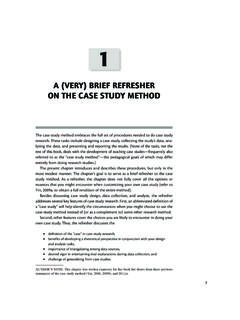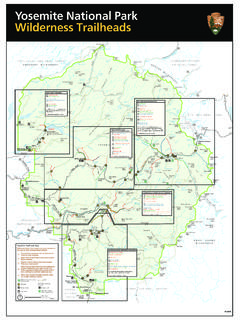Transcription of QUESTIONS/ANSWERS ABOUT NEW ROOF …
1 LEON COUNTY BUILDING INSPECTION. QUESTIONS/ANSWERS ABOUT NEW roof replacement . regulations AS REQUIRED BY On August 21, 2007, the Florida Building Commission (as directed by the Legislature through House Bill 7057) adopted significant changes to the way certain roofing will be regulated statewide. As required by law, effective October 1, 2007, all roof replacements on existing site built single family residential structures constructed prior to implementation of the Florida Building Code (March 1, 2002) must include a secondary water barrier as defined by the new regulations . Additionally, the existing roof decking must be nailed to comply with Section of the new regulations utilizing fasteners as specified by the new regulations .
2 1. When do the new roof replacement regulations become effective? The new regulations become effective October 1, 2007, therefore permits applied for after that date will be required to meet the new regulations . 2. To what type of roof replacement projects does the new law apply? Existing site-built, single family residential structures constructed prior to implementation of the Florida Building Code (March 1, 2002). 3. Can we continue re-roofing over existing roof coverings? Yes, provided the existing roof covering is suitable as a base for the installation of the additional roofing as stipulated by section of the Florida Existing Building Code. 4. If the homeowner chooses to re- roof over the existing roof covering do they still have to comply with these new regulations ?
3 No. Based on the definition of roof replacement as contained in the Florida Building Code, installation of a new roof covering over an existing roof covering, without removing the existing roof covering, does not constitute a roof replacement , which is the trigger that initiates the new roofing regulations . 5. Which local jurisdictions in Florida have adopted the new roofing laws? Local governments did not adopt this law. It was adopted by the Florida Legislature through House Bill 7057, signed by the Governor and applies throughout Florida. Local governments are required to enforce this new, unfunded statutory mandate. 6. Will the cost of roof replacement projects increase in order to comply with these new regulations ? Yes, current estimates from roofing contractors indicate average increases of approximately 30% above what they were prior to implementation of the new regulations .
4 7. When do I call for inspections under the new roofing regulations ? If you are removing the existing roof finish ( roof replacement ); after re-nailing the existing roof deck, call for a nailing inspection using the automated Interactive Voice Response System (IVRS) inspection code 115. When that inspection is approved, install the secondary water barrier and call for a secondary water barrier inspection using the IVRS inspection code 116. Once that inspection is approved, install the roof finish and call for the roof final inspection using the IVRS inspection code 104. If possible, we would like to perform the final inspection when the roof finish is between 50% and 90%. complete. If you are leaving the existing roof finish in place and roofing it ( roof recover), you do not have to re- nail the existing roof deck or install a separate secondary water barrier.
5 You will call for a roof final inspection using IVRS inspection code 104 (as with a roof replacement , if possible we would like to perform the final inspection when the roof finish is between 50% and 90% complete). 8. How long will it take to get an inspection once I call for it? At current staff levels in Leon County (which is 671. square miles), if an inspection is requested before midnight and the actual work is complete at 7:30am on the day the inspection is requested, the inspection will be made that same workday. At a policy level, the inspectors are required to complete all such inspections before they leave work that day. During periods of high inspection demand or staff shortages, it is not uncommon for inspectors to work until dark to finish their daily inspection workload.
6 Last fiscal year, Leon County building inspectors averaged minutes per inspection, when you deduct an average minutes of driving time (assumes an average speed of 30mph) for the average miles between construction sites, only minutes of actual inspection time remains once the inspector arrives at the construction site. With that workload, it is difficult for inspectors to backtrack or give an exact time when a specific inspection will be performed. If an inspection is needed at a specific time, leave a voice message on the automated inspection request system AND call (606-1300) the inspectors ABOUT 7:45am the morning the inspection is to be performed to discuss the specific timing with the inspector. Inspectors attempt to arrange their schedule to benefit the greatest number of contractors while still maintaining the production levels required of them.
7 If the inspector's schedule does not work with your schedule, you have the option of canceling the inspection and rescheduling it for another day. This courtesy not only improves the effectiveness of the inspector's schedule, but also assists the other contractors requesting inspections that day. 9. What is a secondary water barrier? The law defines it as: 1) all joints in roof decking shall be covered with a minimum 4 in. wide strip of self-adhering polymer modified bitumen tape applied directly to the sheathing or decking. The deck and self adhering polymer modified bitumen tape shall be covered with one of the underlayment systems approved for the particular roof covering to be applied to the roof ; OR 2) The entire roof deck shall be covered with an approved self-adhering polymer modified bitumen cap sheet.
8 No additional underlayment shall be required on top of this cap sheet for new installations; OR 3) An asphalt impregnated 30#. felt underlayment installed with nails and tin-tabs as required for the HVHZ, and covered with either an approved self-adhering polymer modified bitumen cap sheet or an approved cap sheet applied using an approved hot-mop application shall be deemed to meet the requirements for the secondary water barrier. 10. Regarding a secondary water barrier, what is a self-adhering polymer modified bitumen cap sheet? The new roofing regulations do not define specifically what this product is; however, the Florida Building Code defines it as a leak barrier complying with ASTM D 1970. 11. What are the new nailing requirements for the roof decking?
9 The specifics of the nailing requirements are contained in Section of the new regulations . However, generally speaking if the existing roof decking is fastened with either staples or 6D nails, the entire roof deck will need to be re-nailed with 8D round head ring shank nails spaced no greater than 6 inches on center. If the existing roof decking is fastened with 8D round head ring shank nails spaced no greater than 6 inches on center, no additional nailing will be required. If the existing roof decking is fastened with 8D clipped head or round head nails, supplemental 8D round head ring shank nails will have to be added such that the maximum spacing between existing and supplemental fasteners is not greater than 6. inches on center.
10 12. Do the roofing requirements apply to multi-family residential, commercial or industrial structures? No. 13. Do the enhanced roof requirements apply to new construction? No. 14. I cannot find many of the requirements in the Statute? Most of the actual specifications are contained in Administrative Rule , which can be viewed on the What's New sidebar at 15. When is gable end bracing required? As currently written, gable end bracing retrofits are not required. They are completely voluntary. 16. Can a roofing contractor include the wall to roof improvements and/or gable end bracing in their contract with the owner and sub-contract this work to a properly licensed residential, building, or general contractor? Yes, provided the majority (more than 50%) of the work performed under the contract is within the scope of the roofing contractors' license.



